#entelegynae
Photo


Huntsman under a Polypore
Unidentified, genus Heteropoda
06/07/22
#huntsman spiders#Giant Huntsman Spiders#Heteropoda#Heteropodinae#Sparassidae#Sparassoidea#Entelegynae#Araneomorphae#Araneae#spiders#spider#spiders tw#Arachnida#Arachnids#Chelicerata#Arthropods#Arthropoda
163 notes
·
View notes
Text
❤️ Such a beautiful Wolf spider with her egg sac. Doing a little rescue, relocating.
Kingdom Animalia (Animals)
Phylum Arthropoda (Arthropods) Subphylum Chelicerata (Chelicerates) Class Arachnida (Arachnids)
Order Araneae (Spiders)
Infraorder Araneomorphae (True Spiders)
No Taxon (Entelegynae)
Family Lycosidae (Wolf Spiders)
Genus Rabidosa

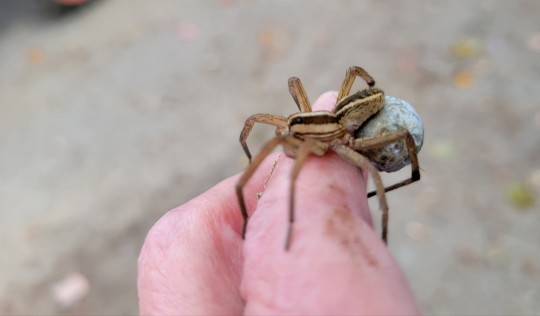

#spider photography#spiders#entomology#photographers on tumblr#nature photography#insect photography#science#southeast kentucky#I love Spiders#macro photography#insects
24 notes
·
View notes
Text
Arylsulfatase A Long-chain-fatty-acid-CoA ligaseg through Man Ejaculation Inside Vitro Capacitation Utilizing Industry Release Scanning Electron Microscopy (FE-SEM)
Testicular nuclei associated with Hamataliwa sp and A. salticus exposed NORs on autosomal pairs, after gold impregnation. Many Oxyopidae spiders their very own karyotype classified by simply the two decline in diploid amount chromosome range modify of the sex chromosome method for you to X variety; nevertheless, specific types offer the our ancestors chromosome structure 2n Is equal to 26+X1X2. Essentially the most remarkable karyotype distinction happened in E. salticus researched the following, which confirmed the cheapest diploid amount actually noticed in Oxyopidae as well as the next lowest listed for #Link# Entelegynae spiders.Many of us describe a clear case of 36-year-old man who offered a new subacute frustration preceded with a 1-month good posterior guitar neck ache with no injury history. Head and neck magnet #Link# resonance image (MRI) studies shared bilateral supratentorial subdural and retroclival extradural hematomas connected with notable cervical epidural venous engorgement. Cerebral and also vertebrae angiography shared simply no abnormalities except dilated cervical epidural veins, All of us carried out serialized follow-up MRI studied to evaluate their situation. Patient's symptoms increased gradually. Sequential radiologic reports uncovered continuous decision involving pathologic results. Any 3-month follow-up MRI review from the mind along with cervical backbone unveiled comprehensive resolution of the retroclival extradural hematoma, disappearance from the cervical epidural venous engorgement, and also partially solution with the bilateral supratentorial subdural hematoma. Total quality with the bilateral supratentorial subdural hematoma ended up being verified with a 5-month follow-up human brain MRI. The diagnosis and possible systems on this rare connection are discussed.With this potential, observational review, we all searched for to look into your chance, risks #Link# , and eating habits study central venous catheter-associated an infection in Sixty people accepted pertaining to hematopoietic come mobile or portable hair loss transplant. In multivariate evaluation, many of us located a 7-fold greater risk involving key line-associated blood vessels disease together with main venous catheter installation in the inside jugular abnormal vein as compared with the subclavian entry. People along with central line-associated system an infection a larger likelihood regarding serious renal failure. Copyright (C) 2013 by the Connection pertaining to Experts inside Contamination Management and Epidemiology, Corporation. Authored by Elsevier Corporation. All rights reserved.The actual submission of creatures in space is usually an important mediator of types connections, but its evolutionary outcomes in those interactions are simply start to become explored. These kind of outcomes could possibly be specially strongly related pathogen-host connections. Expose comprehension of how and when spatial framework can affect the progression associated with pathogen traits probably will support our capability to manage speedily growing transmittable conditions. Take a look at review an evergrowing physique regarding theoretical scientific studies suggesting that will spatial framework can lead to the development associated with an more advanced pathogen tranny charge as well as virulence. We all make clear the outcome of those studies when it comes to the competition-persistence trade-off. These reports highly recommend that will local sponsor friendships, community number dispersal, and comparatively minimal web host processing prices produce a host human population spatial structure that enforces this kind of trade-off and brings about the actual progression of reduced virus transmitting rates as well as virulence. Additionally they declare that while spatial construction is present, it may rule in the type of the transmission-virulence trade-off in deciding virus characteristics.
0 notes
Photo
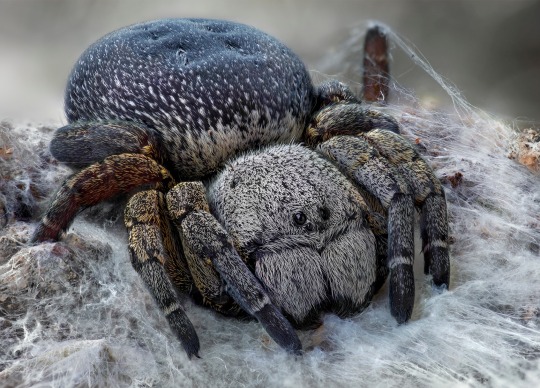
Ladybird spider (Eresus kollari)
Photo by Armen Seropian
#ladybird spider#velvet spider#eresus kollari#eresus#eresidae#entelegynae#araneoclada#opisthothelae#araneomorphae#aranae#arachnida#euchelicerata#chelicerata#arthropoda#ecdysozoa
9K notes
·
View notes
Photo

The triangle weaver spider (Hyptiotes cavatus) holding its web in tension. The ability to store and amplify muscular energy in external devices like bows and catapults was thought to be unique to humans, but a University of Akron study published this month describes how the spider winds up its web and launches itself at prey.
Photograph: SI Han/University of Akron/AFP/Getty Images
(via The week in wildlife – in pictures | Environment | The Guardian)
#Triangle Weaver#Hyptiotes cavatus#Hyptiotes#Uloboridae#Uloboroidea#Entelegynae#Araneomorphae#Araneae#Arachnida#Chelicerata#Arthropoda#spider#Georgia
15 notes
·
View notes
Photo

_Tetragnatha squamata_ #Tetragnatha #Arachnida #Araneae #Opisthothelae #Araneomorphae #Neocribellatae #Entelegynae #Araneoidea green big-jawed #spider nympha#ウロコアシナガグモ 幼体 _Cerasus × yedoensis ‘Somei-yoshino’_ #someiyoshino #floweringcherry #sakura #ソメイヨシノ (総社二子山古墳) https://www.instagram.com/p/BwQnTVOAmN9/?utm_source=ig_tumblr_share&igshid=1fnpg1w5wtz3z
#tetragnatha#arachnida#araneae#opisthothelae#araneomorphae#neocribellatae#entelegynae#araneoidea#spider#ウロコアシナガグモ#someiyoshino#floweringcherry#sakura#ソメイヨシノ
0 notes
Photo
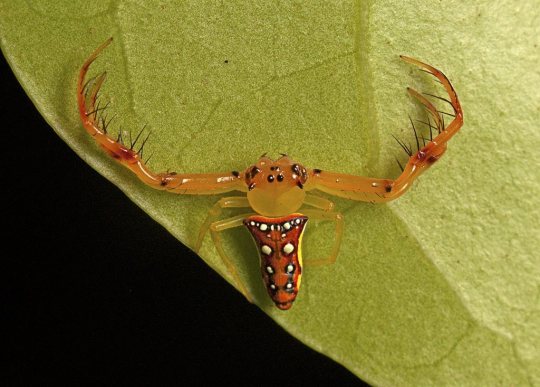
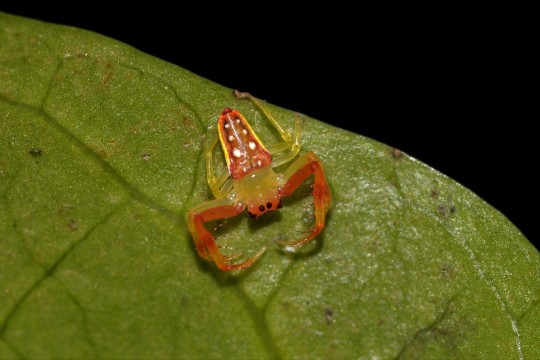
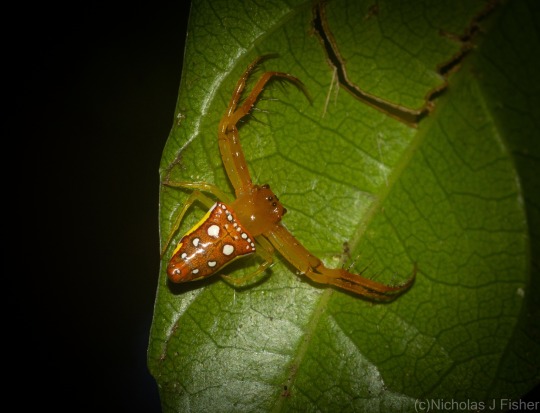
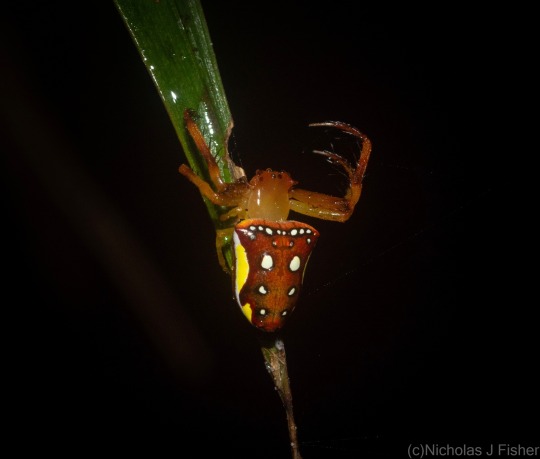
Triangular spider, Arkys bulburinensis, Entelegynae
Found in Australia
Photo 1 by tjeales, 2 by nicklambert, and 3-4 by dustaway
#animals#curators on tumblr#bugs#arachnids#spider#triangular spider#Arkys#Arkys bulburinensis#one nice bug#long arms for giving hugs!!
1K notes
·
View notes
Text
Spiders Use Hydraulics to Move Their Legs
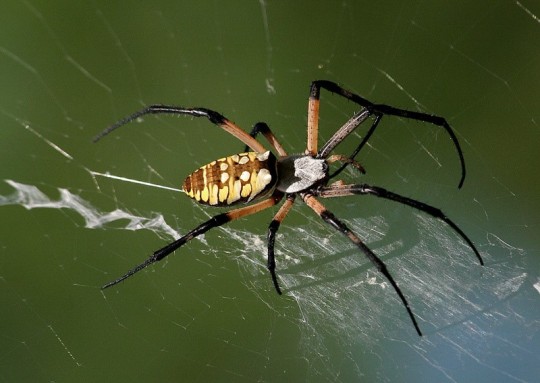
St. Andrews Cross Spider. Photo Credit: Ken Slade
From their unusal and multitudinous eyes to their eight robot-like legs, spiders have a history of receiving a bad rap. While these traits may seem like anatomical abnormalities, there’s a simple physiological explanation for spiders’ odd movements: their legs rely on a combination of hydraulics and skeletal muscles to move.
Spiders are arthropods, which means “joint-footed” creatures. In all arthropods, traditional bones and an internal skeleton have been replaced by a strong, inflexible (but light) exoskeleton (outer shell) made of chitin (the same material as shrimp shells). Since spiders don’t have internal bones, they lack the same movements as vertebrates, like us. Instead, arachnid locomotion is defined by a series of flexions and extenions. To flex their spindly legs inward, spiders use muscles. To extend their legs, however, spiders manipulate the fluid (hemolymph) inside their extermities.
Spiders contain eight legs divided into four locomotory pairs. Each pair of legs performs a specialized task during movement. The spider’s center of mass attaches to each of the extremities, with the forward two pairs in front of the center of mass, and the back two behind. To walk forwards, the front pairs flex inward, pulling the rear of the spider; the third pair pivots to assist with turning; and the fourth pair pushes forward.
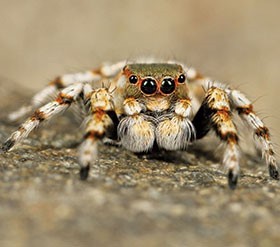
Spider Close-up. Photo Credit: The Journal of Controlled Mechanical Power in Southern Africa
Inside, the spider houses an extensive fluid network. Similar to our blood, arachnids contain hemolymph, a circulatory fluid responsible for moving oxygen, nutrients, and waste throughout the body. Too little fluid, and circulation will be ineffective (low blood pressure). Too much, and the body’s fluid processing systems will be overwhelmed (high blood pressure). For humans, blood pressure extremes can be dangerous, but spiders use these pressure differences to their advantage. When hemolymph enters the legs, and pressure increases, the legs extend. As hemolymph leaves the legs, pressure decreases, and legs retract.
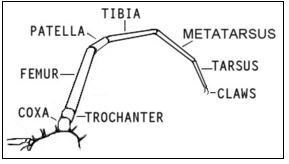
Spider Leg Diagram. Photo Credit: Eky.edu
Within each leg, there are seven tubular sections and three functional regions. The hip joint attaches to the circular body of the spider, allowing multidirectional movement (left, right, up, down). With both extension muscles (to push out) and flex muscles (to pull in the legs), it is the most complex soft tissue arrangement. Below it, the femur-patella and (underneath) tibia-metatarsus facilitate vertical movement. These sections only have flexor muscles; to extend the legs, hemolymph is pumped from the spider’s body to the lower ends of the femur-patella and tibia-metatarsus joints. When full, fluid pressure forces leg extension. As a liquid, the hemolymph fills in the gaps between muscle fibers for efficient extension, while simultaneously stiffening the leg. Not only is this energy efficient, but with only flexor muscles attached to the body, the spider can also maximize muscle volume and stiffness for an ultimately stronger grip on prey.
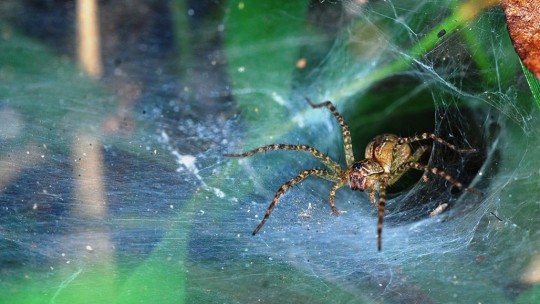
Lawn Wolf Spider in Web. Photo Credit: Person Huang
To jump, spiders fill their legs with hemolymph, extending them as pressure increases. Simultaneously, they flex their muscles, preparing to jump. Upon relaxation, the pressurized legs extend to initiate the jump. Spiders can further influence their in-flight trajectory by manipulating the timing, force, and extension of each leg. Compact atomical positions lead to shorter flights and faster speeds, while spread out limbs behave oppositely. During any jump, a silk line allows the spider to stop descent at any point.
Small spiders (under 3 grams) use liquid (hemolymph) excanges to catapult themselves from one area to the next, facilitating jumping movements and predation. Larger spiders however, require additional muscle forces to move and still their masses, otherwise, they succumb to uncontrollable bouncing with high hydraulic pressure. By combining the hydraulic catapualt strategy of smaller spiders with muscle-based contractions, larger spiders manuever with ease.
Legs aren’t the only hydraulic-powered extremities. In some spiders (Entelegynae), muscular genitalia movements have been replaced with expanding fluid membranes, allowing for increased rotation and higher movement complexity. Why complex genital movements are advantageous is difficult to say. Perhaps hydraulics provide a mechanical advantage for copulation or maybe complex movements improve the lock and sperm transfer. Although the rationale is unclear, the sheer dependence on the hydralics system (for both movement and reproduction) poses a key vulnerability: If a spider’s cephalothorax (center) is damaged, movement will be severely limited, as the hemolyph pressure drops precipitously down to zero.
So the next time you see a spider, stop to consider the wonderous, hydraulic physiology hidden beneath its unusual, jointed exoskeleton. Afterall, it’s hard to squish what you understand.
What’s you favorite part of the spider’s hydraulics system? Leave your comments in the comments section below.
© 2020 Sabrina L. Groves. Creative Commons Attribution-Noncommercial 4.0 International License.
1 note
·
View note
Photo
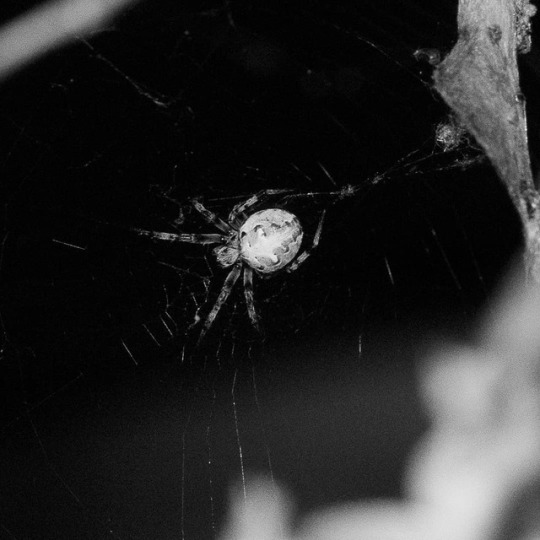
I finally named my spider Charlotte Sometimes but today when I got home, she is gone. I do not see her. And for the last 2 days, she didn't fix her orb web. And there are a few baby spider webs with baby spider webs. It's so cute. The bugguide.net identified the species as Arthropods (Arthropoda) » Chelicerates (Chelicerata) » Arachnids (Arachnida) » Spiders (Araneae) » True Spiders (Araneomorphae) » Entelegynae » Orb Weavers (Araneidae) » Metepeira Here is the official post: https://bugguide.net/node/view/1684492 I believe she has been in my garden through the winter and spring rains. Thank you, Spider aka Charlotte Sometimes.... I named you for Charlotte's Web and a Cure song. In the movie the babies ballooned away. This is the nature of orb spiders. I think some of her babies stayed in my garden. A bird may have ate her or she went away. I don't know. Maybe I will see her again. She had a message for me. Thank you. ❤ https://www.instagram.com/p/Bzwrpk-hGIY/?igshid=1umxkc2a97vzn
0 notes
Photo

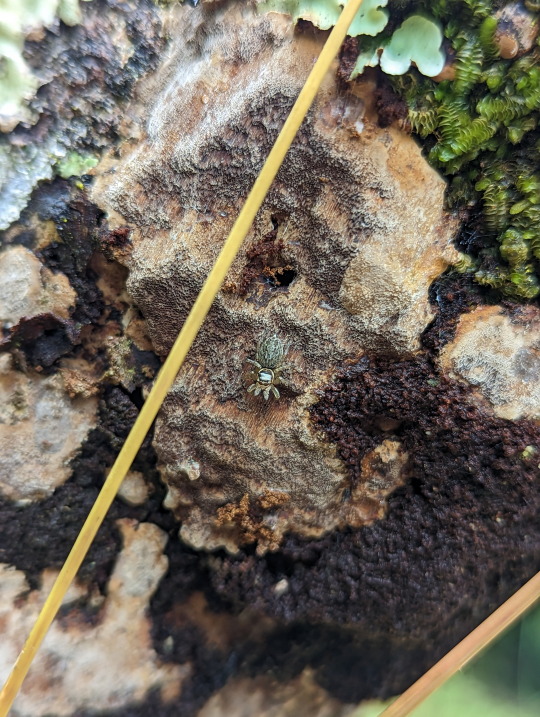
White Banded House Jumper
Maratus griseus
23/02/23
#Maratus griseus#Maratus#White Banded House Jumper#Peacock Spiders#Euophryini#Salticinae#Typical Jumping Spiders#Salticidae#Jumping Spiders#Entelegynae#Araneomorphae#Araneae#spiders#Arachnida#arachnids#arachnaphobia tw#spiders tw#Chelicerata#Chelicerates#Arthropods#Arthropoda#invertblr#invertebrates#bugs#bug#bugblr#bugs tw#insectblr#entomology
33 notes
·
View notes
Photo

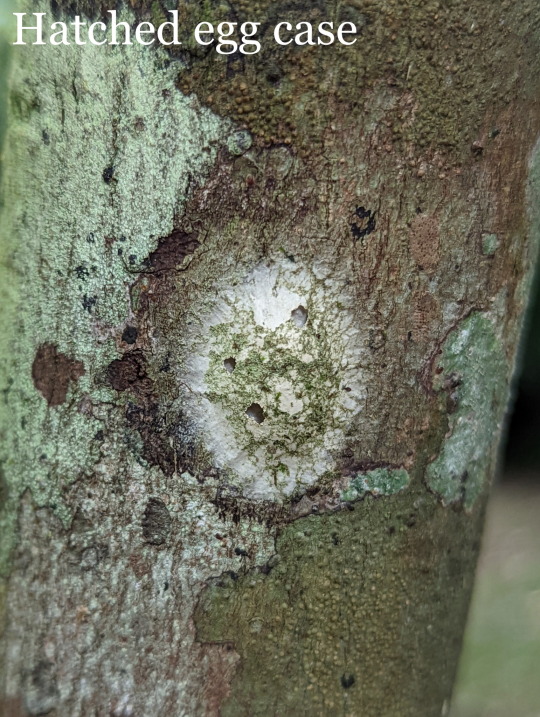

Lichen Huntsman (Pandercetes gracilis)
The eggs, juvenile and adult all on the same tree!
04/05/22
#Pandercetes gracilis#Pandercetes#Lichen Huntsman#Sparassidae#Sparassoidea#Entelegynae#Araneomorphae#Araneae#Arachnida#Chelicerata#camouflage#spiders#spiders tw#arachnids#arachnophobia#bugs#buglr#bugs tw#bug#insects#insecta#insectblr#insects tw#insect#entomology#Arthropods#Arthropoda#nature#natural things
181 notes
·
View notes
Photo
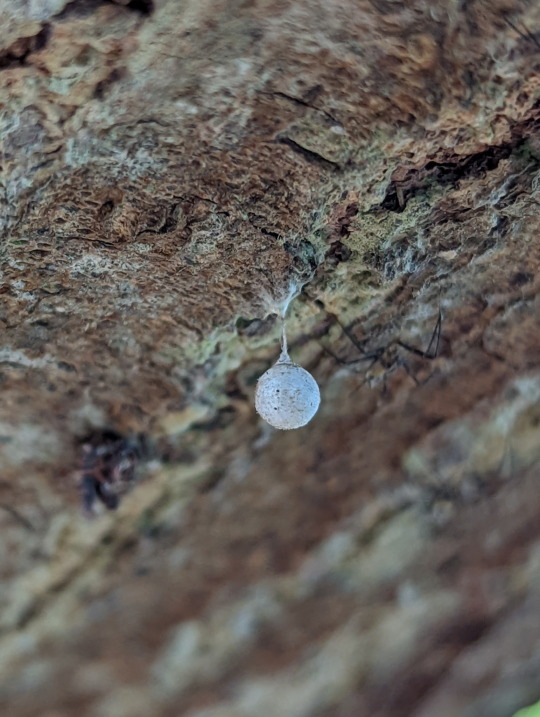
Small Egg Sac
found near the gathering of Assassin Bugs,
Unidentified, Family Hersiliidae
01/06/22
#Hersiliidae#Longspinneret Spiders#Eresoidea#Entelegynae#Araneomorphae#egg sac#eggs#arachnid#Chelicerata#Araneae#Arachnida#Arachnids#spiders#spiders tw#spider#Arthropods#Arthropoda#bugblr#bugs#bugs tw#bug#insects#insectblr#insect#insects tw#entomology#nature
41 notes
·
View notes
Photo
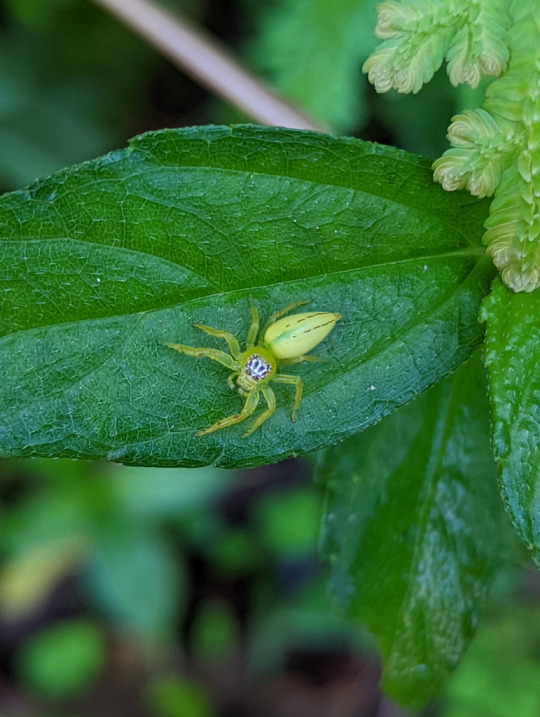
Lovely little Mopsus mormon.
A female one, the males look like small monkeys.
Mopsus mormon
18/05/22
#Mopsus mormon#Mopsus#Chelicerata#Mopsini#Salticinae#Salticidae#Salticoidea#Entelegynae#Araneomorphae#Araneae#Arachnida#spiders#spiders tw#arachnids#jumping spiders#insectblr#bugblr#Arthropods#Arthropoda#nature#nature photography
60 notes
·
View notes
Photo
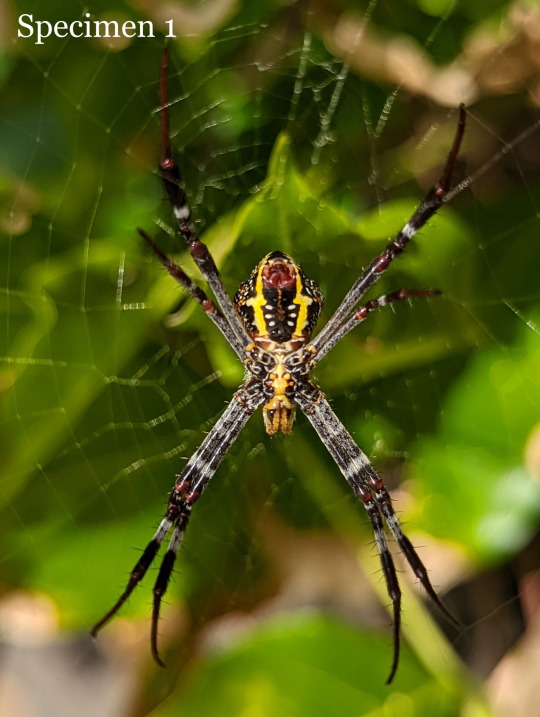
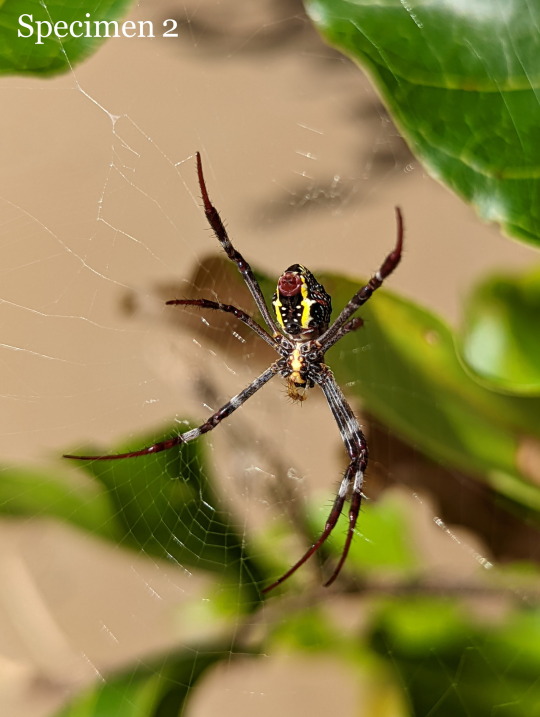
Northern Saint Andrew's Cross Spider
A common garden orbweaver.
Argiope aetherea, “Northern Saint Andrew's Cross Spider”
15/06/22
#Argiope aetherea#Argiope#garden orbweavers#orbweavers#Northern Saint Andrew's Cross Spider#Argiopinae#Araneidae#Araneoidea#Entelegynae#Araneomorphae#Araneae#Arachnida#Chelicerata#Chelicerates#arachnids#spiders tw#spiders#spider
34 notes
·
View notes
Photo

Northern Saint Andrew's Cross Spider.
What a mouthful of a name...
Argiope aetherea
28/05/22
#Argiope aetherea#Argiope#garden orbweavers#orbweavers#Chelicerata#Argiopinae#Araneidae#Araneoidea#Entelegynae#Araneomorphae#Araneae#Arachnida#spiders#spiders tw#arachnids#insects#insect#insects tw#insectblr#bugs#bugs tw#bugblr#Arthropods#Arthropoda
27 notes
·
View notes
Photo
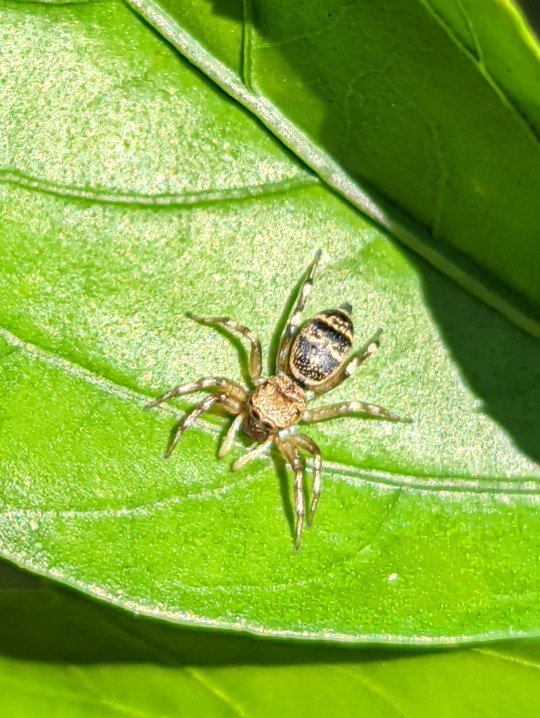
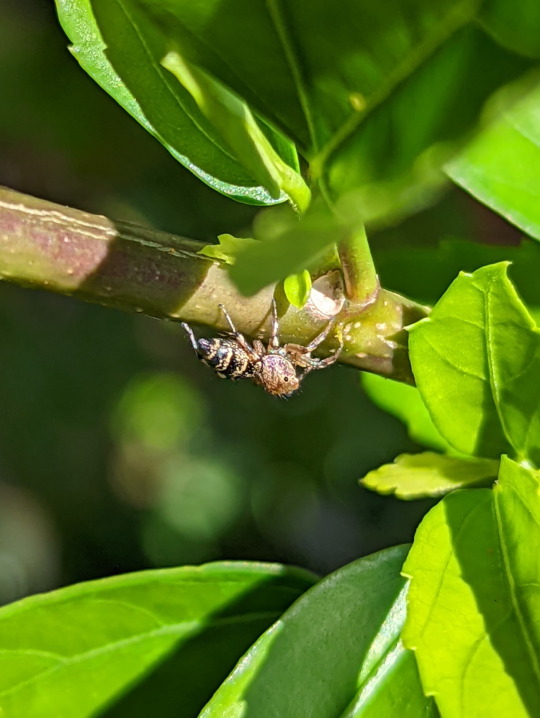
An Iridescent Jumping Spider,
sadly unidentified.
Cosmophasis
30/05/22
#Cosmophasis#Iridescent Jumping Spiders#Chrysillini#Salticinae#Salticidae#Salticoidea#Entelegynae#Araneomorphae#Araneae#Arachnida#arachnids#spiders#jumping spiders#Chelicerata#Chelicerates#Unidentified#spiders tw#bugs#bugs tw#bugblr#insects tw#insectblr#entomology#Arthropods#Arthropoda
26 notes
·
View notes